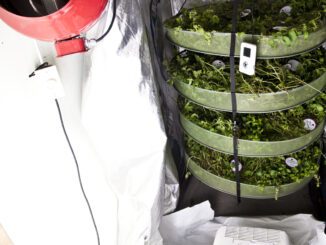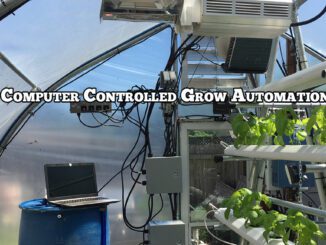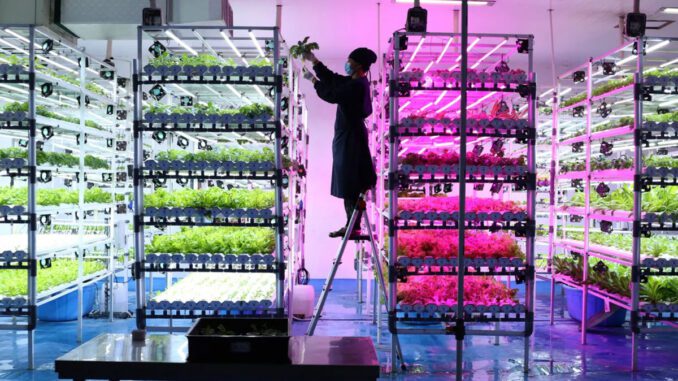
How far can vertical farming go?
Vertical Farming Potential | William Park |
Vertical farming promises a future in which our food is grown in pockets of spaces in our cities and beneath our feet. But how far can it really go?
When the Pasona Urban Farm opened in the nine-storey office of a Japanese recruitment company in 2010, it promised a future in which food was grown within feet of the people who would eat it.
Tomatoes hung down from meeting-room light fittings, a rice paddy filled a large conference space, and mushrooms grew in drawers hidden discreetly under benches. The office looked more like a museum of farming than a place of work.
While the modern concept of vertical farming – growing food in trays or pipes stacked on top of one another like a giant plant lasagne – dates from around the 1990s, it could be argued that farmers have sought ways to grow more in less space and with less soil for centuries. Step-over fruit trees – usually apple and pear trees – are grown as low as 1ft (30cm) off the ground and spread laterally to fill thin strips of space in allotments and orchards. The step-over technique is based on espalier training, which might date back to Ancient Roman grape cultivation.
If we did find a way to overcome the problems of cost and energy use, what would a world where all our food is grown in such farms look like?
But vertical farming in the modern sense is now spreading rapidly. One example is the vertically farmed strawberry brand Oishii, based in New Jersey. In 2021, a punnet of its coveted Japanese Omakase strawberries retailed for $50 (£44) in a high-end New York supermarket. For some, this was evidence that with time vertical farming could rival and ultimately exceed traditional farming for quality. For others, the outlandish price highlighted the huge challenge to make vertical farms commercially viable.
While the technology shows much promise, the costs in both money and energy are still high. This means leafy salads, smaller vegetables and fruits such as tomatoes and strawberries – high value crops which grow quickly – are about the limit of what is currently available commercially from vertical farms.
But where exactly is the limit of what we can actually grow in a vertical farm? And if we did find a way to overcome the problems of cost and energy use, what would a world where all our food is grown in such farms look like? Could we ever move to completely soil-free farming?
Farming upwards
There is no strict definition of what a vertical farm is, but they typically consist of shallow trays stacked within a building, lit with LED lighting at each level. Many vertical farms have no windows and some are even built underground.
These kinds of farms must supply everything – water, nutrients, sunlight and possibly pollinators and pest control too. Others might be built in massive greenhouses – making the most of the Sun’s light and heat, but still controlling other inputs like water.
While sometimes soil is used, increasingly vertical farms use hydroponic or aeroponic systems, where water (for hydroponics) or water vapour (for aeroponics) infused with nutrients is circulated directly around the roots of the plant.
“The water efficiency and nutrient efficiency is really quite high in hydroponics and aeroponics because the roots are able to get those nutrients and water in a lot quicker,” says Laura Vickers, a plant biologist and head of the Urban Farming Group at Harper Adams University in the UK. “There’s no organic matter, there’s nothing else for the plant to compete with or to extract the water from.”
This means using vertical farms can considerably reduce both the water and fertilisers needed to grow food. Meanwhile, the closed-off, controlled environment of vertical farms can help to stop pests getting in – in turn possibly reducing the need for pesticides.
The technology can also allow crops to grow in locations where conventional farming is not possible. Astronauts on the International Space Station, for example, are growing their own food in soilless systems under LED lights – with cabbage, mizuna mustard, lettuce and kale among the crops on the menu.
More generally, though, the small amount of land needed for vertical farms means food can be grown near to cities, says Natalia Falagan, an engineer from Cranfield University in the UK, which could give huge benefits. Shorter supply chains could improve both food security and the quality of food, since the faster food reaches us, the less its nutrients deteriorate and the less unseen toxins, such as mycotoxins, develop. It would also result in far fewer food miles than many imported alternatives and help to guarantee the provenance of crops, she says, while also reducing the burden on natural resources like soil, water and the atmosphere. What’s more, with advanced plant science, the crops could be engineered to be healthier and tastier, she adds.
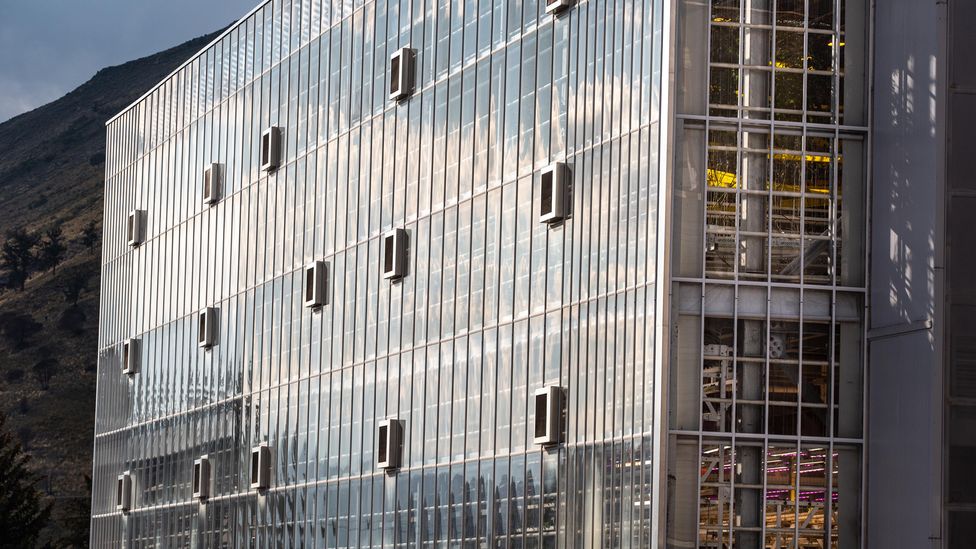
The urban Vertical Harvest in Jackson, Wyoming grows lettuce, micro greens and tomatoes in a large vertical hydroponic farm (Credit: George Rose/Getty Images)
Having vertical farms in the midst of cities could also help to make us more aware of how our food is produced, says Falagan. Pasona Urban Farm, for example, wasn’t just for show – it allowed office workers to harvest their own food at work, which the company hoped would improve both their mental and physical health. Falagan says that having a closer connection with where our food comes from might encourage consumers to be more careful with food waste, too. “If people know how much goes into producing our food,” she says, “then maybe they will think twice about throwing it out.”
Most vertical farms currently concentrate on low-biomass crops – things like herbs, salads and small fruits and vegetables which weigh less per portion – because there is a greater yield for the amount of heat, light and water that needs to be supplied. They also have short life cycles, so make maximum use of space, says Vickers. A leafy green will grow quickly and be ready to harvest in days or weeks, whereas a pumpkin would take months to grow and needs to cure in sunlight.
Salads and herbs do not need to flower and be fertilised, which gives them another advantage over other crops when it comes to vertical farming
A meta-analysis of urban farming in a variety of settings across 53 countries found lettuces, kale and broccoli were particularly suited to vertical farms. Crops like spinach can be grown from seed to harvest in 30 days, meaning a vertical farmer could have 12 harvests from the same tray each year. What’s more, if the farmer were to stagger planting their crop from one row of trays to the next, they could have an almost continuous supply of food all year round from their farm – something a traditional farmer can only dream of.
Lost bees
Salads and herbs do not need to flower and be fertilised, which gives them another advantage over other crops when it comes to vertical farming. Most fruits and vegetables do require pollination, and where it is needed for vertical farms it would have to be done artificially at a cost. (Read more about how humans are farming a wider variety of tiny insect livestock than ever before.)
Farmers already often rely on commercial bees to encourage pollination and maximise fruiting for both indoor and outdoor farming. For example, the almond industry, of which 85% is based in California’s Central Valley, depends on billions of honey bees that are shipped tens of thousands of miles to and from Florida to pollinate the almond blossoms each year. The hives are brought in on trucks and the bees are released into each grove before being moved on to the next farm. In the UK, strawberries grown in polytunnels are also pollinated with commercial honey bees – though, curiously, pollination by wild bees results in larger fruits.

Plant petals reflect UV light to attract bees, as illustrated in this ultraviolet-induced visible fluorescence image of Gazania flowers (Credit: Calvin Jennings/Getty Images)
Commercial bee pollination has already been applied to indoor farming, says Vickers. But using bees in an indoor environment poses a problem – the artificial lights can make it difficult for bees to navigate.
To humans, indoor farms often appear illuminated in neon pinks and purples. This is because plants grow best when exposed to mostly blue and red wavelength light, which to us looks pink or purple from a distance. But bee vision is very different from ours. They cannot see the colour red, but can see in the ultraviolet (UV) spectrum, which humans cannot. Outdoors, plant petals reflect UV to help bees navigate to them. This puts bees at a distinct disadvantage in vertical farms, where UV is currently not used. Adding it could make indoor farms even more expensive, especially considering this same light is completely free for outdoor farmers.
“We think about vertical farming from the plant’s perspective,” says Vickers. “And we don’t think about what the bee sees and how it finds the plants. The bees struggle to navigate under the current LEDs.”
Vertical grains
Other crops, such as cereals, are pollinated by wind, which could be easily replicated by creating a draught within the vertical farm, says Vickers. But while there are some examples of vertical farms experimenting with growing cereals, it’s still rare. “Barley or wheat, which takes many months to grow, are not currently cost effective,” says Vickers.
The reason for this high cost is the biggest barrier to the widespread use of vertical farms – they require huge amounts of energy and infrastructure. While being able to grow crops year-round increases the efficiency of a vertical farm, the challenge these farms face is to keep energy use down when the alternative – growing outside – comes with free sunlight and rainwater. This reliance on energy can also make vertical farms highly vulnerable to volatile energy prices.
In many places, the electricity used to power vertical farms also still comes from fossil fuels, meaning overall greenhouse gas emissions can be far higher than for open-field farming. Switching to renewable energy is the obvious way to reduce this carbon footprint, although, since most renewables themselves require land, this can reduce the land-saving benefits of indoor farming somewhat.
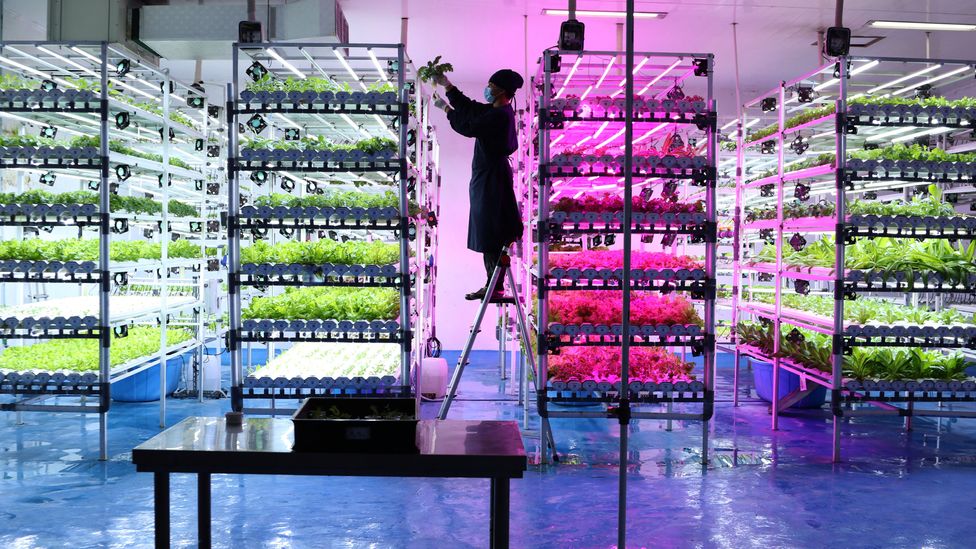
Farmers tend to illuminated vegetable crops inside the Sentral Farm building, in West Java, Indonesia (Credit: Dasril Roszandi/Getty Images)
Botanically speaking, barley or wheat are quite possible within a vertical farming system due to their short root structure, says Vickers, which is important for growing them in trays.
And while it’s unlikely we’ll ever grow all our grains in vertical farms, it could still prove to be useful in some situations. In 2020, agricultural scientists from several US universities published an article arguing vertical farming might one day play a role in hedging against future unexpected supply chain disruptions. As the ongoing war in Ukraine has highlighted the world’s dependence on cereals from eastern Europe and sparked a search for alternative sources, it may be a proposal worth considering.
Indoor orchards
But Vickers says that it is actually woody crops, such as fruit trees, which would really test the limits of what is possible to grow in a vertical farm, not least because they would require significant support without soil. Botanically, however, there is no reason that indoor orchards are not possible, she says.
“A tree already is a kind of vertical farm,” says Mark Horler, chair of the UK Urban AgriTech, which represents the country’s indoor agriculture community. “Trees take water with nutrients in it, and distribute it across a series of layers that then grow leaves and fruits. As ever, nature was there first.”
Along with Kerstin Schreiber, a geographer at McGill University, Horler is co-founder of the Soya Project, an initiative set up to promote the benefits of vertical farming. He is currently investigating the potential of growing willow saplings indoors in vertical farms to speed up their growth before being planted outside, and so to hopefully increase their survival rate. “The rate of failure in reforestation and afforestation projects is phenomenal,” he says, citing how vulnerable saplings are to the elementswhen they are very small (in one study, 83% of replanted trees died within 10 years). “Only a really small proportion make it to the final grade.”
But if given the head start, Horler hopes the saplings will stand a better chance. And he’s not the only one looking to vertical farming to give trees a boost. Zoe M Harris, an environmental scientist from the University of Surrey in the UK, is leading a similar project which has recently been awarded £4m ($4.8m) in UK government funding, while a project propagating apple tree saplings in aeroponic systems started in England last year. Early trials of a vertical farm project in Scotland managed to grow tree seedlings six times faster than is typical in traditional outdoor sowing.
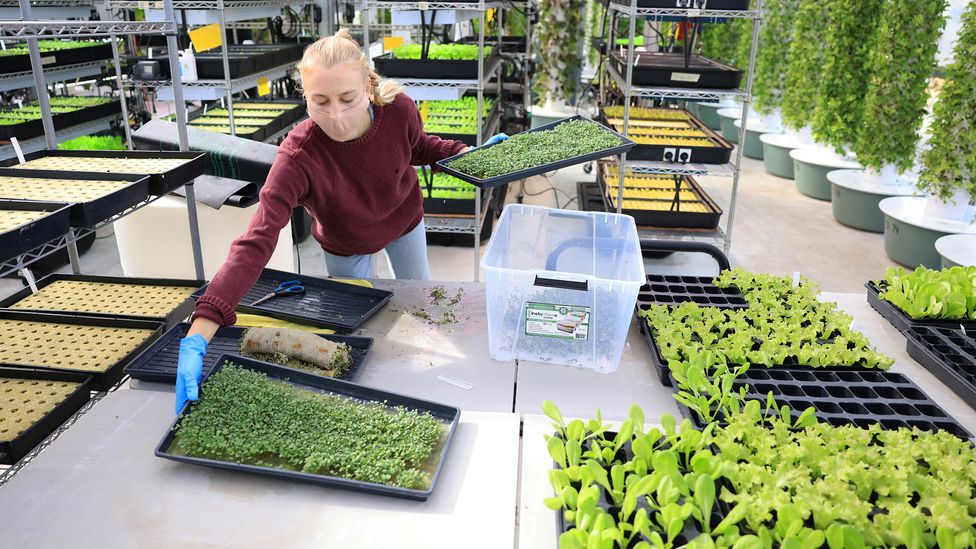
Vertical farms – such as the Altius farm in Denver, Colorado pictured here – is now spreading rapidly (Credit: Kevin Mohatt/Alamy)
Horler says he sees no reason why trees couldn’t be grown permanently indoors for food. A vertical orchard might look a bit different to the ones we are used to seeing, however. “What you’d want is a series of thin saplings that fruit really often, rather than waiting for one tree which produces all its fruit all at once,” says Horler. Most apple trees are already dwarf varieties of wild species, he says, so dwarfing them further isn’t out of the question.
In Asia, dwarf mango trees are being trialled because the smaller variety helps harvesters pick their fruits. And in 2019, a collective of researchers were able to produce a tomato plant that, in Horler’s words, “almost looks like a bunch of grapes”– the tiny plant was covered in ripe tomatoes.
Plant scientists would need to solve some long-standing problems before all our food could be grown vertically, says Laura Vickers
Dwarfing crops makes them more suitable for vertical farming, agrees Vickers. But the variety that performs best outdoors won’t necessarily be the variety that performs best within a controlled environment, she adds, so dwarfing an established variety might not always work. For example, certain varieties might perform best outdoors because they are hardy to temperature variations or diseases, which might not be such important factors indoors.
Vertically farmed trees and crops that take longer to mature might also be tricky to keep disease-free, says Vickers. Between harvests of herbs and salads, a vertical farmer can sterilise trays before the next crop is planted. However, mango trees, for example, can take years to mature, in which time mould and bacteria can thrive.
“The disease has the time of its life because – just like the plant – it has the perfect environment, perfect temperature, perfect amount of oxygen, perfect nutrients and access to all these lovely plants as well,” says Vickers.
If conditions are ideal, however, Horler says a vertically farmed tree might be able to actually invest more in its fruits. “A plant will devote its resources to what it thinks it can do best,” he says. “If it’s being tested, then it will put more effort into protecting itself from harder conditions…[But] if it’s in ideal conditions and having an easy life, then it will grow lots of leaves and flowers and fruit, it won’t grow these massive metres-long root systems.”
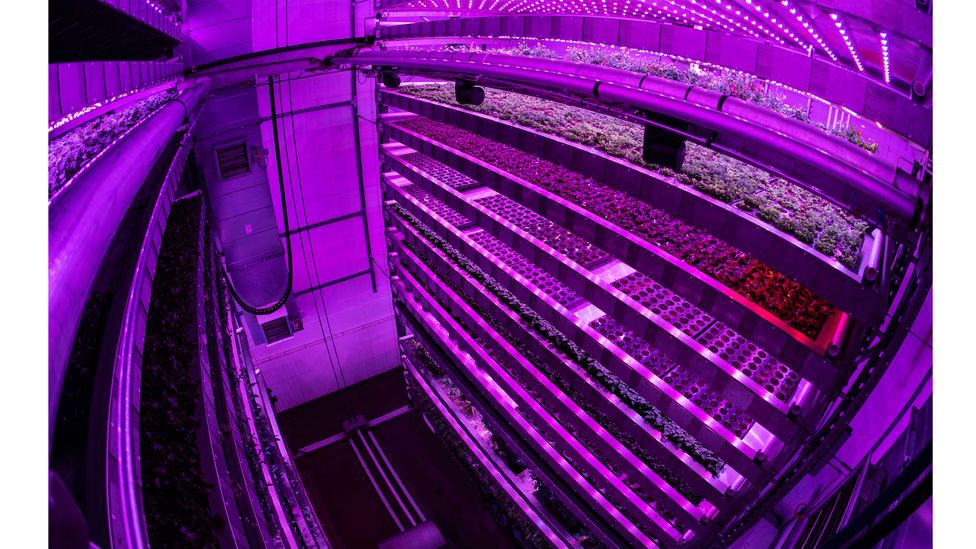
Pink light illuminates a vertical farm in Invergowrie, Scotland. Plants grow best when exposed to mostly blue and red wavelength light (Credit: Andy Buchanan/Getty Images)
There is no botanical reason, then, why all our food couldn’t be grown vertically, but plant scientists will need to solve some long-standing problems before this is a reality, says Vickers. And, of course, city planners, renewable energy providers and farmers themselves would all have a huge part to play.
It is worth noting, though, that much of the benefits and limitations of vertical farming explained by Vickers and Horler refer to farming on large scales in developed countries.
Smallholders produce 30-34% of the global food supply. Some nations are heavily dependent on subsistence farming, and it is perhaps unrealistic that this essential food supply would be transformed by vertical farming, which is dependent on secure electricity.
However, reducing the land taken up by industrial farming by shifting it to vertical farms could in theory free up space that could be used for restoring ecosystems, or even handed back to these same smallholder farmers or be used for regenerative farming methods, which tend to require more space.
Vickers says that vertical farms might one day allow for an “intellectual supply chain” in which plants’ growth cycles can be sped up or slowed down to react to changes in demand. (Vickers was once approached by a party interested in producing bespoke salad mixes personalised to customers’ dietary needs, but says “the premise is, at the moment, in its infancy”.)
Experimenting further with crops in vertical farms could also create other possibilities for how we experience our food, like encouraging the plants to create more taste compounds, vitamins or antioxidants. Falagan says that this can be done by stressing the crops, for example by reducing their water, or exposing the harvested food to certain gases while in storage.
But while these innovations could find their place in sustainable farming methods in the future, when money is a consideration it is hard to see all of them happening soon, says Vickers.
The Pasona Urban Farm experiment that took over a Tokyo high-rise office, for example, is no longer there. The rice has been cut, the tomatoes picked, and the mushrooms have been taken out of their drawers.
For now, we will have to content ourselves with salads, small fruits and vegetables until the time that orchards grow in our cities.
Original Article: https://www.bbc.com/future/article/20230106-what-if-all-our-food-was-grown-in-indoor-vertical-farms

